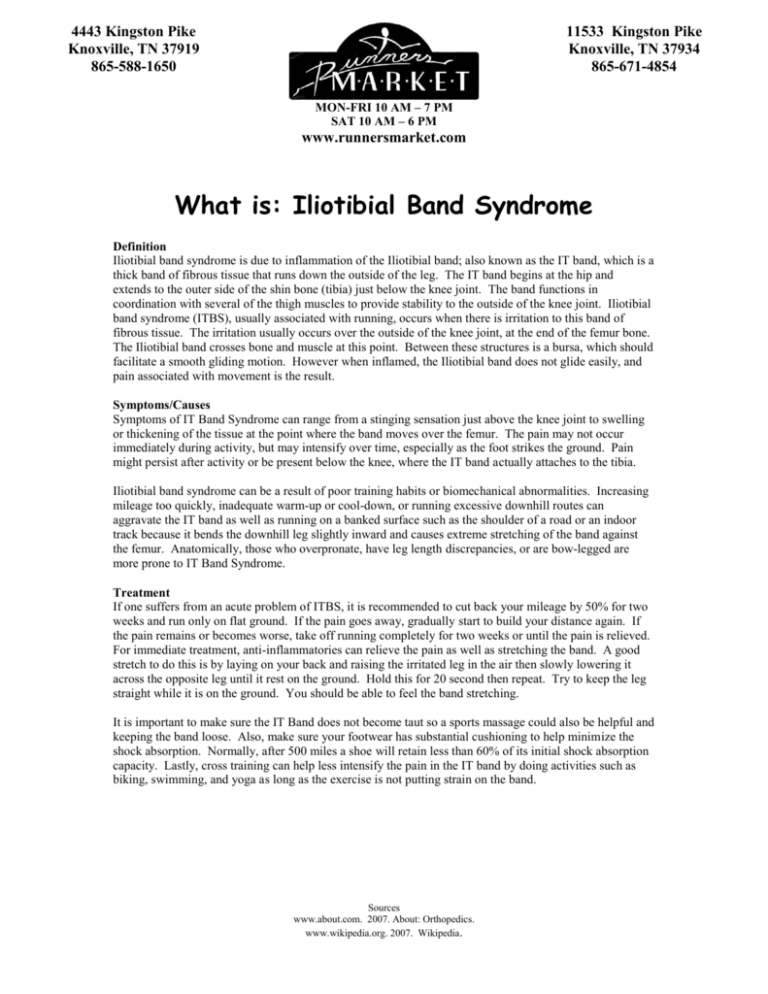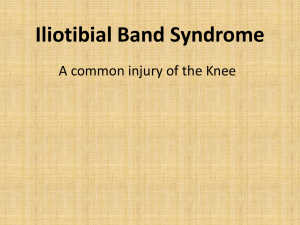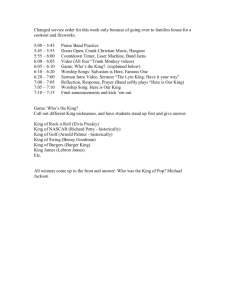information. - Runners Market
advertisement

4443 Kingston Pike Knoxville, TN 37919 865-588-1650 11533 Kingston Pike Knoxville, TN 37934 865-671-4854 MON-FRI 10 AM – 7 PM SAT 10 AM – 6 PM www.runnersmarket.com What is: Iliotibial Band Syndrome Definition Iliotibial band syndrome is due to inflammation of the Iliotibial band; also known as the IT band, which is a thick band of fibrous tissue that runs down the outside of the leg. The IT band begins at the hip and extends to the outer side of the shin bone (tibia) just below the knee joint. The band functions in coordination with several of the thigh muscles to provide stability to the outside of the knee joint. Iliotibial band syndrome (ITBS), usually associated with running, occurs when there is irritation to this band of fibrous tissue. The irritation usually occurs over the outside of the knee joint, at the end of the femur bone. The Iliotibial band crosses bone and muscle at this point. Between these structures is a bursa, which should facilitate a smooth gliding motion. However when inflamed, the Iliotibial band does not glide easily, and pain associated with movement is the result. Symptoms/Causes Symptoms of IT Band Syndrome can range from a stinging sensation just above the knee joint to swelling or thickening of the tissue at the point where the band moves over the femur. The pain may not occur immediately during activity, but may intensify over time, especially as the foot strikes the ground. Pain might persist after activity or be present below the knee, where the IT band actually attaches to the tibia. Iliotibial band syndrome can be a result of poor training habits or biomechanical abnormalities. Increasing mileage too quickly, inadequate warm-up or cool-down, or running excessive downhill routes can aggravate the IT band as well as running on a banked surface such as the shoulder of a road or an indoor track because it bends the downhill leg slightly inward and causes extreme stretching of the band against the femur. Anatomically, those who overpronate, have leg length discrepancies, or are bow-legged are more prone to IT Band Syndrome. Treatment If one suffers from an acute problem of ITBS, it is recommended to cut back your mileage by 50% for two weeks and run only on flat ground. If the pain goes away, gradually start to build your distance again. If the pain remains or becomes worse, take off running completely for two weeks or until the pain is relieved. For immediate treatment, anti-inflammatories can relieve the pain as well as stretching the band. A good stretch to do this is by laying on your back and raising the irritated leg in the air then slowly lowering it across the opposite leg until it rest on the ground. Hold this for 20 second then repeat. Try to keep the leg straight while it is on the ground. You should be able to feel the band stretching. It is important to make sure the IT Band does not become taut so a sports massage could also be helpful and keeping the band loose. Also, make sure your footwear has substantial cushioning to help minimize the shock absorption. Normally, after 500 miles a shoe will retain less than 60% of its initial shock absorption capacity. Lastly, cross training can help less intensify the pain in the IT band by doing activities such as biking, swimming, and yoga as long as the exercise is not putting strain on the band. Sources www.about.com. 2007. About: Orthopedics. www.wikipedia.org. 2007. Wikipedia.





